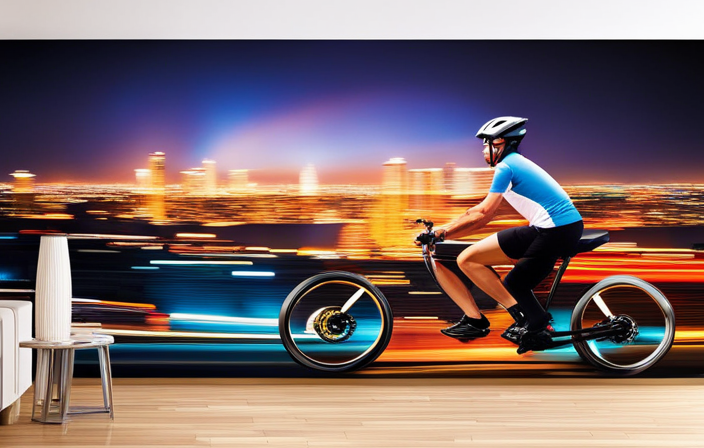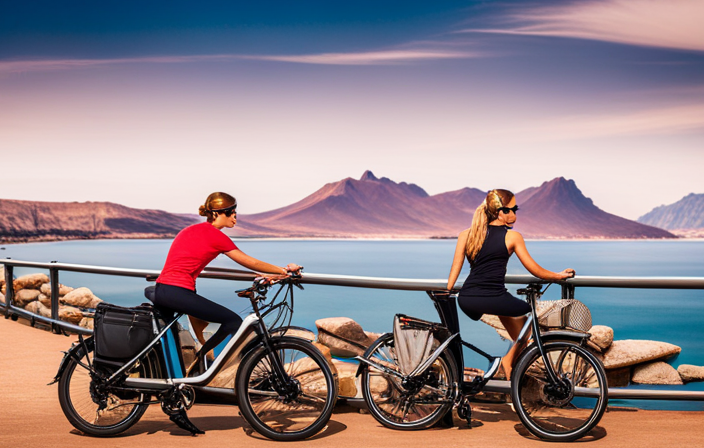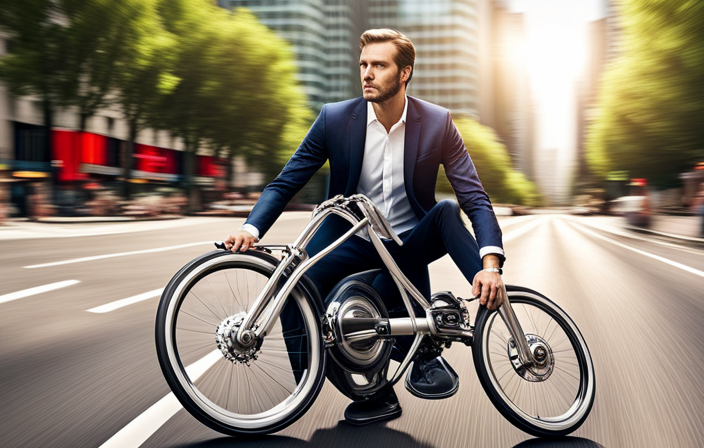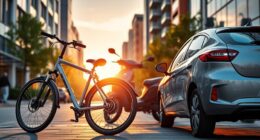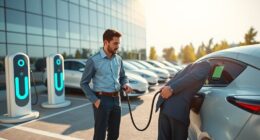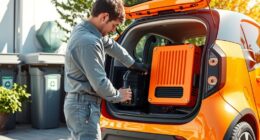As an avid cyclist, I’ve always been fascinated by the thrill of speed. And now, with the rise in popularity of electric bikes, I find myself wondering just how fast these powerful machines can go.
In this article, we’ll delve into the world of electric bike speed, exploring the factors that impact it, the legal limits, and the top speeds of popular models.
So, buckle up and get ready to experience the exhilaration of speed on an electric bike like never before.
Key Takeaways
- Electric bike speed limits typically range from 20 to 28 miles per hour.
- The speed of an electric bike is influenced by factors such as motor power, battery capacity, terrain, motor efficiency, and speed control mechanisms.
- Electric bikes are classified into Class 1, Class 2, and Class 3 based on their speed capabilities, with Class 1 and Class 2 having a speed limit of 20 mph and Class 3 allowing speeds up to 28 mph.
- Factors affecting electric bike speed include motor power and wattage, battery capacity and voltage, and the terrain and riding conditions.
Understanding Electric Bike Speed Limits
To understand electric bike speed limits, you should know that they typically range from 20 to 28 miles per hour.
The speed of an electric bike is determined by various factors such as motor power and acceleration. The motor power directly affects how fast the bike can go. Higher motor power results in faster speeds, allowing you to reach the upper limit of the speed range.
Additionally, speed tuning and modifications can also influence the maximum speed of an electric bike. By adjusting the settings or making modifications to the bike, it is possible to increase its top speed. However, it is important to note that modifying the bike’s speed may also have legal implications, as exceeding speed limits can be against the law.
Understanding the factors that impact electric bike speed is crucial for both safety and compliance with regulations.
Factors That Impact Electric Bike Speed
When it comes to electric bike speed, there are several key factors that play a crucial role.
Firstly, the motor power and wattage determine how much power is being delivered to the bike’s wheels, and ultimately, how fast it can go.
Secondly, the battery capacity and voltage are important as they directly impact the bike’s range and performance, allowing for higher speeds.
Lastly, the terrain and riding conditions cannot be overlooked, as uphill climbs or rough terrains might slow down the bike, while smooth and flat surfaces might enable it to reach higher speeds.
Motor Power and Wattage
The motor power and wattage determine how fast an electric bike can go. The efficiency of the motor plays a crucial role in achieving high speeds. Here are three key points to understand motor power and wattage:
-
Motor Efficiency: The efficiency of the motor determines how effectively it can convert electrical energy into mechanical power. Higher motor efficiency means more power is delivered to the wheels, resulting in faster speeds.
-
Speed Control Mechanisms: Electric bikes are equipped with different speed control mechanisms, such as throttle or pedal-assist systems. These mechanisms regulate the power output of the motor, allowing riders to control their speed and achieve desired levels of acceleration.
-
Wattage: The wattage rating of the motor indicates its power output. Higher wattage motors can generate more power, enabling the bike to reach higher speeds.
Understanding the motor power and wattage is crucial in determining the speed capabilities of an electric bike.
Now, let’s delve into the next aspect: battery capacity and voltage.
Battery Capacity and Voltage
Understanding battery capacity and voltage is crucial for determining the performance of an e-bike. The battery capacity refers to the amount of energy the battery can store, while voltage refers to the electrical pressure or power it can deliver. These two factors directly impact the battery life and charging time of an e-bike.
A higher capacity battery will generally provide a longer range, allowing you to ride for a longer distance before needing to recharge. On the other hand, a higher voltage battery can deliver more power, resulting in faster acceleration and higher top speeds.
It’s important to consider your riding needs and preferences when choosing the right battery capacity and voltage for your e-bike. With a better understanding of battery capacity and voltage, we can now explore how terrain and riding conditions affect the performance of an e-bike.
Terrain and Riding Conditions
Consider the type of terrain and riding conditions you’ll encounter to ensure optimal performance of your e-bike. Riding techniques and the impact of wind speed can greatly affect your overall experience.
When riding on hilly terrains, it’s important to engage the appropriate gear and maintain a steady pedaling rhythm to overcome the inclines efficiently. For off-road trails, having good suspension and wider tires will provide better traction and stability. In urban environments, maneuverability and quick acceleration are key, so a bike with a smaller frame and higher torque would be ideal.
Additionally, wind speed can significantly affect your e-bike’s speed and battery life. Riding against the wind requires more power, reducing your overall range. Conversely, riding with the wind can give you a boost and extend your battery life.
Understanding these factors will help you choose the right e-bike for your specific needs and ensure an enjoyable riding experience.
Now, let’s delve into the legal speed limits for electric bikes.
Legal Speed Limits for Electric Bikes
Electric bikes have specific speed limits that riders must follow. When exploring speed regulations, it’s interesting to note the variations among different countries. Here are some key points to consider:
-
In the United States, electric bikes are typically limited to a top speed of 20 mph, with the motor providing assistance up to that point.
-
In Europe, the regulations differ from country to country. For example, in Germany, electric bikes are limited to 15.5 mph, while in the Netherlands, the limit is set at 25 km/h (15.5 mph).
-
In Australia, the speed limit for electric bikes is 25 km/h (15.5 mph), with the exception of certain states where the limit is set at 20 km/h (12.4 mph).
Understanding the speed limits for electric bikes is essential for riders to ensure they are riding within the legal boundaries.
Now, let’s transition into discussing the types of electric bikes and their speed capabilities.
Types of Electric Bikes and Their Speed Capabilities
When it comes to electric bikes, there are three main classes to consider: Class 1, Class 2, and Class 3.
Class 1 electric bikes are equipped with a pedal-assist system that can propel the bike up to 20 miles per hour.
Class 2 electric bikes have a throttle that allows the rider to reach speeds of up to 20 miles per hour without pedaling.
Class 1 Electric Bikes
You can ride Class 1 electric bikes on public roads and bike paths. These bikes are equipped with a pedal-assist system that provides assistance up to a speed of 20 mph.
Here are three key points to understand about Class 1 electric bikes and their speed capabilities:
-
Motor Efficiency: Class 1 electric bikes are designed to provide efficient motor assistance. The motor is programmed to deliver power in a way that optimizes energy usage and extends the battery life. This ensures that you can maintain a consistent speed without draining the battery quickly.
-
Impact of Weight on Speed: The weight of the rider and any additional cargo can affect the speed of a Class 1 electric bike. Heavier loads may require more power from the motor, which can slightly reduce the overall speed. However, these bikes are still capable of reaching the maximum speed of 20 mph, even with added weight.
-
Safety on Public Roads: Class 1 electric bikes are allowed on public roads and bike paths because they provide pedal-assisted assistance, promoting active transportation while maintaining a reasonable speed limit. This makes them a convenient and eco-friendly option for commuting and recreational riding.
Transitioning into the next section about Class 2 electric bikes, it’s important to note that they have a different speed capability and operational mode.
Class 2 Electric Bikes
Now that we have learned about Class 1 electric bikes, let’s move on to understanding Class 2 electric bikes.
Class 2 electric bikes are equipped with a throttle that allows riders to propel the bike without pedaling. They can reach speeds up to 20 mph, making them ideal for both leisurely rides and commuting.
One of the benefits of Class 2 electric bikes is the flexibility they offer. You can choose to pedal-assist when you want some exercise or use the throttle when you need a break. This versatility makes Class 2 electric bikes suitable for riders of all fitness levels.
Additionally, Class 2 electric bikes are still considered pedal-assist, meaning you can ride them on bike paths and trails where Class 3 electric bikes may be restricted.
Speaking of which, let’s move on to the next section about Class 3 electric bikes.
Class 3 Electric Bikes
Class 3 electric bikes are equipped with a motor that assists riders when pedaling, allowing them to reach speeds up to 28 mph. Understanding Class 3 regulations is important for anyone considering purchasing an electric bike. Here are some key benefits of Class 3 electric bikes:
-
Increased Speed: With the assistance of the motor, riders can reach higher speeds, making their commutes faster and more efficient.
-
Extended Range: The motor helps riders cover more distance with less effort, allowing for longer rides without feeling fatigued.
-
Health Benefits: Even with the motor assistance, riders still need to pedal, providing a great form of exercise and promoting cardiovascular health.
-
Eco-Friendly Transportation: Opting for a Class 3 electric bike reduces reliance on cars and helps reduce carbon emissions, contributing to a cleaner environment.
Transitioning to the subsequent section about the top speeds of popular electric bike models, it’s fascinating to explore the capabilities of these innovative modes of transportation.
Top Speeds of Popular Electric Bike Models
The top speeds of popular electric bike models vary depending on the specific model and brand. When it comes to electric bikes, the motor power and acceleration play a crucial role in determining the top speed. Higher motor power generally means faster acceleration and higher top speeds.
However, it is important to note that the rider’s weight can also have an impact on the top speed. Heavier riders may experience slightly lower top speeds due to the additional load on the motor.
It is always recommended to check the manufacturer’s specifications for each electric bike model to determine its top speed.
Now, let’s move on to some tips for maximizing your electric bike speed and getting the most out of your ride.
Tips for Maximizing Your Electric Bike Speed
If you want to get the most out of your ride, there are a few tips for maximizing your e-bike speed. To achieve optimal acceleration and improve aerodynamics, follow these steps:
-
Optimize your body position: Lean forward slightly and tuck your elbows in to reduce wind resistance.
-
Use pedal assist wisely: Start pedaling before engaging the motor to take advantage of the added power and increase your acceleration.
-
Keep your tires properly inflated: Maintaining the correct tire pressure ensures better traction and reduces rolling resistance, allowing for faster speeds.
By implementing these tips, you can significantly increase your e-bike speed and enjoy a more exhilarating ride.
However, it’s important to consider safety considerations when riding at high speeds.
Safety Considerations When Riding at High Speeds
Be cautious when riding at high speeds on your e-bike, as safety considerations become even more crucial. When pushing the limits of your electric bike’s speed, it is vital to take certain safety precautions to ensure your well-being.
First and foremost, always wear appropriate protective gear such as a helmet, knee pads, and elbow guards. These will provide essential protection in case of a fall or accident.
Additionally, make sure your e-bike is in optimal working condition, with properly inflated tires and functioning brakes. It is also important to be aware of your surroundings and anticipate any potential hazards on the road.
By following these safety measures, you can enjoy the thrill of riding at high speeds while minimizing the risks involved.
As we delve into the world of speed records and achievements in the electric bike realm, it is fascinating to see the incredible feats that have been accomplished.
Speed Records and Achievements in the Electric Bike World
Experience the thrill of breaking speed records and achieving remarkable feats in the world of electric biking. Electric bike speed competitions have become increasingly popular, pushing the boundaries of what these bikes can do. Here are some notable achievements in the world of electric bike speed:
-
The current world speed record for an electric bike stands at an impressive 183.9 mph, set by a team in France.
-
In recent years, there have been numerous attempts to break the 200 mph barrier, with riders coming close but not quite reaching the mark.
-
Electric bike speed competitions often take place on closed tracks or designated roads, ensuring safety for both riders and spectators.
-
These events showcase the incredible potential of electric bikes, demonstrating their ability to rival traditional motorcycles in terms of speed and performance.
As the demand for faster electric bikes continues to grow, manufacturers are constantly working on future developments in electric bike speed technology.
Future Developments in Electric Bike Speed Technology
Get ready for the exciting advancements in electric bike speed technology that are on the horizon. As technology continues to advance, it is no surprise that electric bikes are becoming faster and more powerful. Manufacturers are constantly pushing the boundaries to create electric bikes that offer exhilarating speeds and performance. In the future, we can expect to see improvements in battery technology, motor efficiency, and aerodynamics, all contributing to increased speed capabilities. However, it is important to note that as electric bike speeds increase, there may be a need for stricter speed regulations to ensure safety on the roads. Nevertheless, the future of electric bike speed technology looks promising, and riders can look forward to an even more thrilling and exhilarating experience on their electric bikes.
| Future Advancements | Speed Regulations |
|---|---|
| Improved battery technology | Stricter speed limits |
| More efficient motors | Safety certifications |
| Enhanced aerodynamics | Enforced speed control measures |
| Advanced power management systems | Compliance with road regulations |
| High-performance components | Mandatory safety gear |
With these exciting advancements in electric bike speed technology, riders can look forward to faster and more thrilling experiences on their electric bikes. However, it is important to remember that safety should always be a top priority.
Conclusion: Enjoying the Thrill of Speed on an Electric Bike
As technology continues to evolve, I can anticipate even more exhilarating moments on my e-bike. With advancements in electric bike speed technology, I can now maximize acceleration and experience the thrill of high-speed riding.
One of the key benefits of an e-bike is its ability to provide instant torque, allowing riders to quickly reach top speeds. By utilizing the power of the electric motor, I can easily accelerate to higher speeds and enjoy the rush of wind in my face.
However, it’s important to remember that high-speed riding comes with its own set of risks. It is crucial to wear proper safety gear, such as a helmet and protective clothing, and to always obey traffic laws. Additionally, riders should be mindful of their surroundings and ride within their skill level to minimize the risks associated with high-speed riding.
Overall, while maximizing acceleration on an e-bike can be incredibly thrilling, it is important to prioritize safety at all times.
Frequently Asked Questions
Are there any age restrictions for riding an electric bike at high speeds?
There are typically no age restrictions for riding an electric bike at high speeds. However, it’s important to follow local speed limits and take into account the rider’s ability to safely handle the bike at higher speeds.
Can you modify an electric bike to increase its top speed?
Sure, you can modify an electric bike to increase its top speed. By upgrading the motor, battery, and controller, you can achieve significant speed gains. One interesting statistic is that some modified electric bikes can reach speeds of over 60 mph!
What safety gear should I wear when riding an electric bike at high speeds?
When riding an electric bike at high speeds, it is crucial to prioritize safety. To ensure your well-being, wearing safety gear such as a helmet, knee and elbow pads, and sturdy shoes is highly recommended. Additionally, it is essential to adhere to the recommended speed limits for your bike model.
Are there any specific maintenance requirements for electric bikes that are ridden at high speeds?
When riding an electric bike at high speeds, it is important to consider specific maintenance requirements. To optimize performance, regular check-ups on the battery, motor, and brakes are necessary. Performance upgrades can also enhance the overall riding experience.
Are there any legal consequences for exceeding the speed limits on an electric bike?
Exceeding speed limits on an electric bike can have legal consequences. It’s like playing with fire, risking potential accidents and injuries. Safety should always be prioritized to mitigate the risks of riding at high speeds.
Conclusion
In conclusion, electric bikes provide an exciting and efficient way to travel. Their speed capabilities are a major draw for enthusiasts. One interesting statistic to note is that the current world record for the fastest electric bike speed stands at an astonishing 236.5 mph (380.8 km/h). This incredible feat showcases the potential of electric bike technology and the continuous advancements being made in the field.
As technology continues to evolve, it is safe to say that electric bikes will only become faster and more exhilarating to ride. So, hop on your electric bike and experience the thrill of speed!
